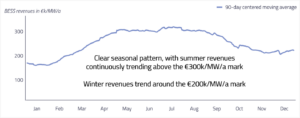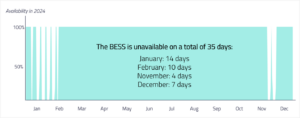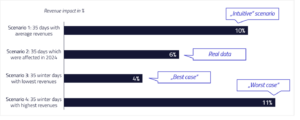

Batteries in a Constrained World: Evaluating Grid Constraints for BESS Projects (Part 2)

Introduction & Recap
In our previous article, we explored the foundational steps to evaluate grid constraints for BESS projects. We covered two critical aspects:
Insights from Step 1: Understanding BESS Behavior
We learned that BESS operations vary significantly by season and market dynamics. Seasonal differences drive charging and discharging patterns—winter operations focus on nighttime charging and evening discharging, while summer operations are dictated by PV production. Furthermore, market segmentation is key: participation in the Day-Ahead market (DAA) is driven by fundamentals, whereas Intraday Continuous (IDC), FCR, and aFRR respond to short-term volatility.
Insights from Step 2: Understanding Grid Constraints
To properly assess the impact of grid constraints, developers and investors must analyze several factors. These include the timing of restrictions—whether they occur seasonally or in response to specific events—their extent, the frequency and operational limits imposed, and the level of advance notice provided by grid operators. Another crucial aspect is whether or not the operator offers financial compensation for restrictions, which can have a significant influence on a project’s financial viability.
Today, we move to Step 3, where we take a real-world example to assess the revenue impact of grid constraints and examine practical mitigation strategies.
Case Study: Snow Cannon Operations and Grid Constraints in Alpine Regions
Project Overview
This BESS project is located near the Alps, where snow cannons create a significant load on the grid during winter months. To mitigate grid stress, the grid operator has the right to influence the operation of the BESS asset during peak demand periods.
Did you know? The snow cannons in the Alps consume so much energy that during peak snowmaking season, their electricity usage can rival that of a small city! In fact, a single large ski resort can use up to 3 GWh of electricity per season—enough to power thousands of households for a year!
Applying our evaluation framework from Part 1, we analyze this project considering four key dimensions:
- Timing: The grid operator can foresee snow cannon usage well in advance and must communicate any operational restrictions at least two days before they take effect. These constraints are imposed exclusively during winter months when snow production is required.
- Extent: The grid operator can restrict access on up to 10% of the days annually, meaning that during these periods, the BESS asset must remain offline or operate at reduced capacity.
- Communication: Since the operator provides sufficient advance notice, the exact method of notification is not as critical given the 2-day lead time.
- Compensation: No financial compensation is provided for the restricted days.
Assessing the Financial Impact
To evaluate the financial impact of these grid constraints, we consider different scenarios. A simplistic view, assuming no seasonality in revenues, suggests that a 10% restriction on operations would result in a direct 10% revenue loss. However, a more detailed analysis reveals that revenues are not evenly distributed throughout the year, making the actual impact more nuanced.
By analyzing a 90-day moving average revenue trend, we observe that revenues are significantly lower in winter compared to summer. This seasonal revenue pattern indicates that the financial impact of winter restrictions is likely to be lower than initially expected.

Graph 1: BESS revenues in €k/MW/a, 90-day centered moving average revenue
The grid operator provided data indicating the specific days affected by restrictions. In total, the asset was unavailable for 35 days, with the majority of restrictions occurring in January (14 days) and February (10 days).

Graph 2: BESS availability in 2024 based on input from the grid operator
Using this data, we can quantify the financial impact in 2024: The actual revenue reduction due to restrictions was 6%, significantly lower than the 10% projected in a simplistic model.
To further explore possible outcomes, we construct two additional scenarios:
- Scenario 3: If the 35 restricted days corresponded to the lowest-revenue days in winter (Winter months considered are November to February), the impact would be only 4%.
- Scenario 4: If the 35 restricted days coincided with the highest-revenue days in winter, the impact would rise to 11%, slightly exceeding the simplistic 10% assumption.
The seasonality effect, which we anticipate persisting in future years, significantly mitigates the financial impact of imposed restrictions, as winter months consistently generate lower revenues.

Graph 3: BESS revenues impact in 2024: Scenario analysis
Summary of Financial Assessment
This analysis underscores the importance of considering seasonality when evaluating the financial impact of grid constraints. While a straightforward assumption suggests that a 10% operational restriction would lead to a proportional 10% revenue loss, real-world revenue distribution tells a different story. Due to lower revenues in winter months, the actual revenue impact in 2024 was measured at only 6%—a significant reduction from the initial estimate. Further sensitivity analysis demonstrated that, depending on the timing of restricted days, the impact could range from as low as 4% to as high as 11%.
The key takeaway is that seasonality plays a crucial role in mitigating the financial effects of grid constraints. Restrictions imposed during periods of lower revenue naturally reduce their impact, whereas constraints imposed on high-revenue days can lead to greater losses. This highlights the necessity for robust scenario planning to quantify potential outcomes accurately and ensure financial resilience.
Conclusion & Guidance for Operators and Developers
While grid constraints introduce revenue uncertainty, strategic planning and proactive engagement with grid operators can help mitigate risks. To better navigate these challenges, operators and developers should:
- Engage in Compensation Discussions: Explore financial compensation mechanisms, to offset revenue losses. Possibilities include payments for periods affected from constraints or other compensation mechanisms such as lowering the BKZ (grid usage charges).
- Optimize Contractual Agreements: Ensure that contracts explicitly define restriction periods and mechanisms, in our example preventing the grid operator from imposing constraints during higher-revenue summer months.
- Leverage Historical Data: Use past restriction patterns to forecast and plan operational strategies that minimize financial impacts.
By proactively incorporating these strategies, operators can better safeguard their assets against the financial downsides of grid constraints while maximizing long-term profitability.
Summary and Outlook
In this article, we applied our framework to assess the impact of grid constraints on a BESS project affected by snow cannon operations. The key takeaways include:
- Seasonal revenue differences significantly influence the financial impact of restrictions.
- Clear contractual planning and negotiation with grid operators are essential to safeguarding business cases.
- Historical data and sensitivity analyses provide critical insights for informed decision-making.
This case study demonstrates that not all grid constraints fundamentally threaten a BESS business case. Despite operational restrictions during winter, the asset remains fully available during high-revenue summer months. The financial impact, though present, is mitigated by seasonality effects, allowing the project to maintain overall viability.
However, not all grid constraints are as manageable. In the next part of this series, we will explore cases where restrictions are so severe that they undermine the entire business case. These examples will highlight the red flags developers and investors should watch for when assessing project feasibility.



